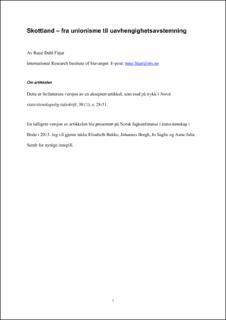| dc.contributor.author | Fitjar, Rune Dahl | |
| dc.coverage.spatial | Scotland | en_US |
| dc.date.accessioned | 2021-11-09T12:29:53Z | |
| dc.date.available | 2021-11-09T12:29:53Z | |
| dc.date.created | 2014-11-12T12:26:55Z | |
| dc.date.issued | 2014 | |
| dc.identifier.citation | Fitjar, R.D. (2014) Skottland – fra unionisme til uavhengighetsavstemning. Norsk Statsvitenskapelig Tidsskrift, 30 (1), 29-51. | en_US |
| dc.identifier.issn | 0801-1745 | |
| dc.identifier.uri | https://hdl.handle.net/11250/2828686 | |
| dc.description.abstract | Ved parlamentsvalget i 1955 vant Scottish Unionist Party rent flertall i Skottland med 50,1 prosent av stemmene, og Skottlands forhold til unionen var knapt på dagsorden. Et halvt århundre senere har Skottland betydelig selvstyre gjennom sitt eget parlament og skal avholde en folkeavstemning om uavhengighet i 2014. Hva har skjedd i Skottland i løpet av disse årene? Hvorfor ønsker stadig flere skotter selvstyre og sågar uavhengighet? Artikkelen belyser viktige utviklingstrekk i Skottland som kan bidra til å forstå denne utviklingen. Jeg tar for meg viktige endringer i skotsk politikk og økonomi gjennom siste halvdel av det 20. århundre og drøfter hvordan disse kan bidra til en forståelse av den territorielle mobiliseringen i Skottland i samme periode. Dette gjelder faktorer som europeisk integrasjon, endringer i det skotske partisystemet, økonomisk vekst og oljevirksomhet. I tillegg drøftes fremveksten av Scottish National Party og dets rolle i å fortolke disse endringene. Artikkelen benytter både kvantitative og kvalitative data til å belyse Skottlands politiske og økonomiske utvikling og ser dette i sammenheng med territoriell mobilisering i Skottland, uttrykt ved oppslutningen om uavhengighet og selvstyre. | en_US |
| dc.description.abstract | The Scottish Unionist Party won a majority of the Scottish votes at the 1955 Westminster elections, and Scotland’s relationship to the union was barely on the agenda. Half a century later, Scotland has considerable autonomy resting in its own Parliament and is staging a referendum on independence in 2014. What has happened in Scotland during this half century? Why do an increasing number of Scots want autonomy and even independence? The article discusses political and economic processes in Scotland that can contribute to understanding this development. It highlights important changes in Scottish politics and economy during the second half of the 20th century and discusses how these relate to territorial mobilisation in Scotland during the same timeframe. The discussion covers processes of European integration, party system divergence, economic growth and petroleum production. Furthermore, the article discusses the emergence and growth of the Scottish National Party and its role in interpreting these changes. The analysis uses both quantitative and qualitative data to illustrate the political and economic development of Scotland and examines how these changes may have affected territorial mobilisation in Scotland in the form of increased support for independence and autonomy. | en_US |
| dc.language.iso | nob | en_US |
| dc.publisher | Universitetsforlaget | en_US |
| dc.rights | Navngivelse-Ikkekommersiell 4.0 Internasjonal | * |
| dc.rights.uri | http://creativecommons.org/licenses/by-nc/4.0/deed.no | * |
| dc.subject | selvstyre | en_US |
| dc.subject | uavhengighet | en_US |
| dc.subject | nasjonalisme | en_US |
| dc.subject | territoriell mobilisering | en_US |
| dc.subject | autonomy | en_US |
| dc.subject | independence | en_US |
| dc.subject | nationalism | en_US |
| dc.subject | Skottland | en_US |
| dc.title | Skottland – fra unionisme til uavhengighetsavstemning | en_US |
| dc.type | Peer reviewed | en_US |
| dc.type | Journal article | en_US |
| dc.description.version | acceptedVersion | en_US |
| dc.subject.nsi | VDP::Samfunnsvitenskap: 200::Statsvitenskap og organisasjonsteori: 240 | en_US |
| dc.source.pagenumber | 29-51 | en_US |
| dc.source.volume | 30 | en_US |
| dc.source.journal | Norsk Statsvitenskapelig Tidsskrift | en_US |
| dc.source.issue | 1 | en_US |
| dc.identifier.cristin | 1172240 | |
| cristin.ispublished | true | |
| cristin.fulltext | postprint | |
| cristin.qualitycode | 1 | |

